Analysis of wild-type and mutant SL3-3 murine leukemia virus insertions in the c-myc promoter during lymphomagenesis reveals target site hot spots, virus-dependent patterns, and frequent error-prone gap repair
- PMID: 15596802
- PMCID: PMC538719
- DOI: 10.1128/JVI.79.1.67-78.2005
Analysis of wild-type and mutant SL3-3 murine leukemia virus insertions in the c-myc promoter during lymphomagenesis reveals target site hot spots, virus-dependent patterns, and frequent error-prone gap repair
Abstract
The murine leukemia retrovirus SL3-3 induces lymphomas in the T-cell compartment of the hematopoetic system when it is injected into newborn mice of susceptible strains. Previously, our laboratory reported on a deletion mutant of SL3-3 that induces T-cell tumors faster than the wild-type virus (S. Ethelberg, A. B. Sorensen, J. Schmidt, A. Luz, and F. S. Pedersen, J. Virol. 71:9796-9799, 1997). PCR analyses of proviral integrations in the promoter region of the c-myc proto-oncogene in lymphomas induced by wild-type SL3-3 [SL3-3(wt)] and the enhancer deletion mutant displayed a difference in targeting frequency into this locus. We here report on patterns of proviral insertions into the c-myc promoter region from SL3-3(wt), the faster variant, as well as other enhancer variants from a total of approximately 250 tumors. The analysis reveals (i) several integration site hot spots in the c-myc promoter region, (ii) differences in integration patterns between SL3-3(wt) and enhancer deletion mutant viruses, (iii) a correlation between tumor latency and the number of proviral insertions into the c-myc promoter, and (iv) a [5'-(A/C/G)TA(C/G/T)-3'] integration site consensus sequence. Unexpectedly, about 12% of the sequenced insertions were associated with point mutations in the direct repeat flanking the provirus. Based on these results, we propose a model for error-prone gap repair of host-provirus junctions.
Figures

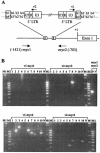
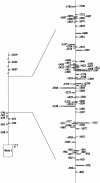
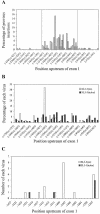
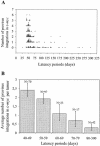
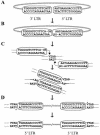
Similar articles
-
Stability of AML1 (core) site enhancer mutations in T lymphomas induced by attenuated SL3-3 murine leukemia virus mutants.J Virol. 1997 Jul;71(7):5080-7. doi: 10.1128/JVI.71.7.5080-5087.1997. J Virol. 1997. PMID: 9188573 Free PMC article.
-
Mutation of all Runx (AML1/core) sites in the enhancer of T-lymphomagenic SL3-3 murine leukemia virus unmasks a significant potential for myeloid leukemia induction and favors enhancer evolution toward induction of other disease patterns.J Virol. 2004 Dec;78(23):13216-31. doi: 10.1128/JVI.78.23.13216-13231.2004. J Virol. 2004. PMID: 15542674 Free PMC article.
-
Enhancer mutations of Akv murine leukemia virus inhibit the induction of mature B-cell lymphomas and shift disease specificity towards the more differentiated plasma cell stage.Virology. 2007 May 25;362(1):179-91. doi: 10.1016/j.virol.2006.12.016. Epub 2007 Jan 29. Virology. 2007. PMID: 17258785
-
Genetic heterogeneity in acute myeloid leukemia: maximizing information flow from MuLV mutagenesis studies.Leukemia. 2000 Jul;14(7):1174-84. doi: 10.1038/sj.leu.2401852. Leukemia. 2000. PMID: 10914539 Review.
-
Retroviral integration: Site matters: Mechanisms and consequences of retroviral integration site selection.Bioessays. 2015 Nov;37(11):1202-14. doi: 10.1002/bies.201500051. Epub 2015 Aug 21. Bioessays. 2015. PMID: 26293289 Free PMC article. Review.
Cited by
-
In vitro murine leukemia retroviral integration and structure fluctuation of target DNA.PLoS One. 2012;7(2):e31533. doi: 10.1371/journal.pone.0031533. Epub 2012 Feb 14. PLoS One. 2012. PMID: 22348097 Free PMC article.
-
Detecting statistically significant common insertion sites in retroviral insertional mutagenesis screens.PLoS Comput Biol. 2006 Dec 8;2(12):e166. doi: 10.1371/journal.pcbi.0020166. Epub 2006 Oct 24. PLoS Comput Biol. 2006. PMID: 17154714 Free PMC article.
-
Identification of novel Bach2 transcripts and protein isoforms through tagging analysis of retroviral integrations in B-cell lymphomas.BMC Mol Biol. 2009 Jan 21;10:2. doi: 10.1186/1471-2199-10-2. BMC Mol Biol. 2009. PMID: 19159451 Free PMC article.
-
Activation of an oncogenic microRNA cistron by provirus integration.Proc Natl Acad Sci U S A. 2006 Dec 5;103(49):18680-4. doi: 10.1073/pnas.0609030103. Epub 2006 Nov 22. Proc Natl Acad Sci U S A. 2006. PMID: 17121985 Free PMC article.
-
HERVs in neuropathogenesis.J Neuroimmune Pharmacol. 2010 Sep;5(3):326-35. doi: 10.1007/s11481-010-9214-y. Epub 2010 Apr 27. J Neuroimmune Pharmacol. 2010. PMID: 20422298 Review.
References
-
- Agresti, A. 1990. Categorical data analysis. Wiley, New York, N.Y.
Publication types
MeSH terms
Substances
LinkOut - more resources
Full Text Sources
Molecular Biology Databases
Miscellaneous

